UK Retail Sector: Sainsbury's Workplace Transformation Challenges
VerifiedAdded on 2023/06/18
|25
|4926
|207
Case Study
AI Summary
This case study investigates the challenges faced by Sainsbury's, a UK retail sector company, in implementing workplace transformation due to the global pandemic. The study aims to understand the concept of workplace transformation, analyze the factors impacting it during the pandemic, identify specific challenges faced by Sainsbury's, and recommend strategies to mitigate these effects. The research employs a qualitative approach, utilizing primary data collected through questionnaires from 30 Sainsbury's employees and secondary data from relevant literature. Data analysis reveals that while employees are generally aware of workplace transformation, significant challenges include remote working difficulties, economic uncertainties, increased requirements, and skills shortages. The study concludes by offering recommendations for Sainsbury's to enhance its workplace transformation strategies.
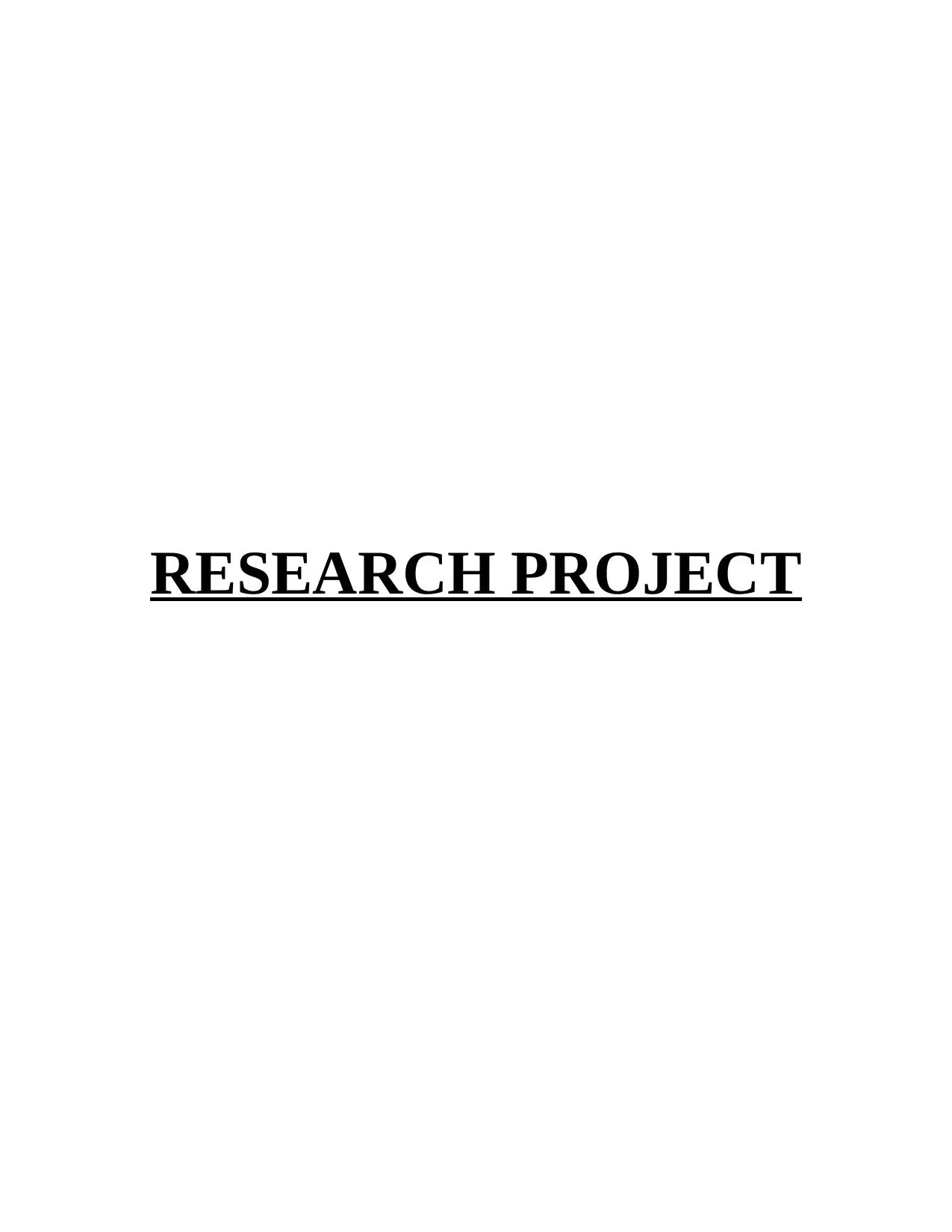
RESEARCH PROJECT
Paraphrase This Document
Need a fresh take? Get an instant paraphrase of this document with our AI Paraphraser
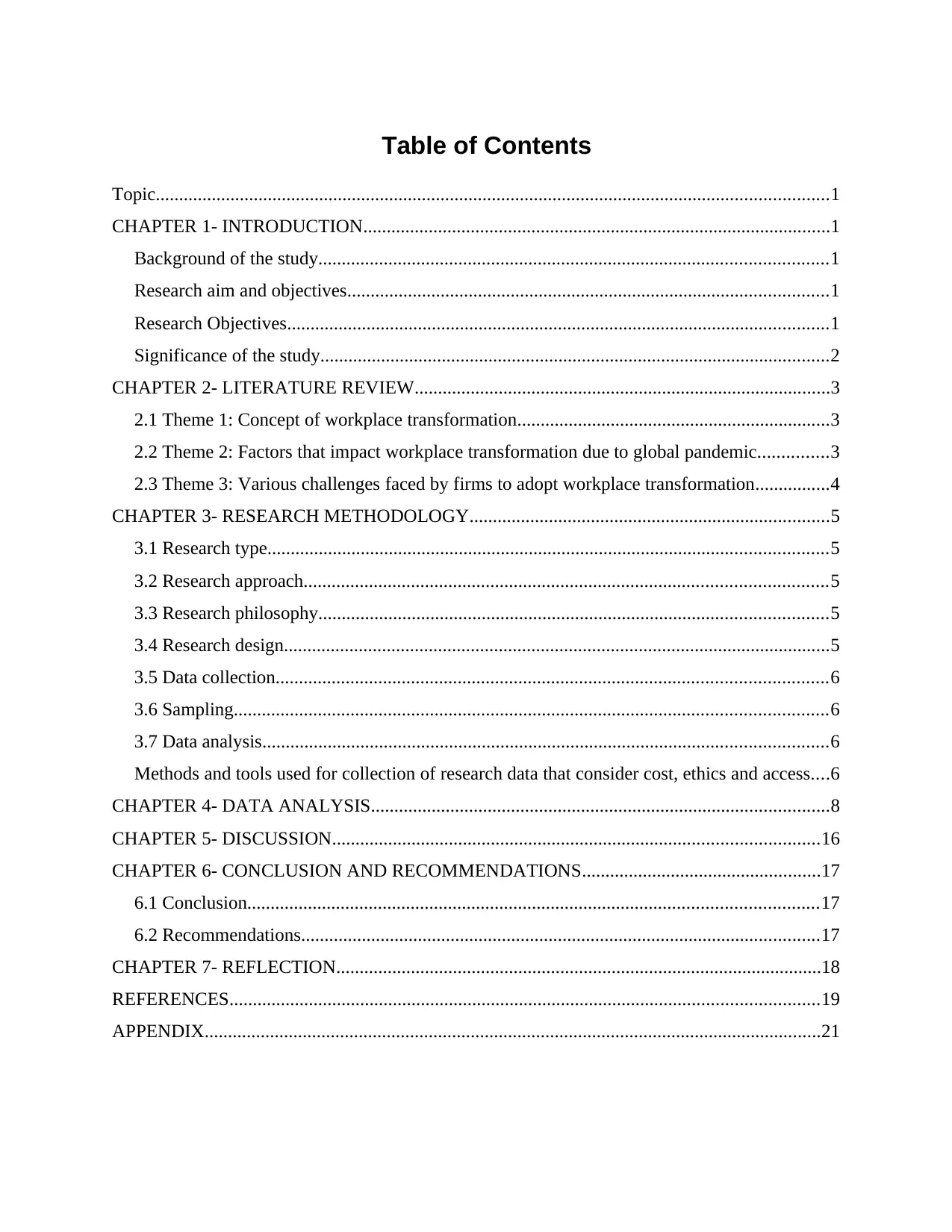
Table of Contents
Topic................................................................................................................................................1
CHAPTER 1- INTRODUCTION....................................................................................................1
Background of the study.............................................................................................................1
Research aim and objectives.......................................................................................................1
Research Objectives....................................................................................................................1
Significance of the study.............................................................................................................2
CHAPTER 2- LITERATURE REVIEW.........................................................................................3
2.1 Theme 1: Concept of workplace transformation...................................................................3
2.2 Theme 2: Factors that impact workplace transformation due to global pandemic...............3
2.3 Theme 3: Various challenges faced by firms to adopt workplace transformation................4
CHAPTER 3- RESEARCH METHODOLOGY.............................................................................5
3.1 Research type........................................................................................................................5
3.2 Research approach................................................................................................................5
3.3 Research philosophy.............................................................................................................5
3.4 Research design.....................................................................................................................5
3.5 Data collection......................................................................................................................6
3.6 Sampling...............................................................................................................................6
3.7 Data analysis.........................................................................................................................6
Methods and tools used for collection of research data that consider cost, ethics and access....6
CHAPTER 4- DATA ANALYSIS..................................................................................................8
CHAPTER 5- DISCUSSION........................................................................................................16
CHAPTER 6- CONCLUSION AND RECOMMENDATIONS...................................................17
6.1 Conclusion..........................................................................................................................17
6.2 Recommendations...............................................................................................................17
CHAPTER 7- REFLECTION........................................................................................................18
REFERENCES..............................................................................................................................19
APPENDIX....................................................................................................................................21
Topic................................................................................................................................................1
CHAPTER 1- INTRODUCTION....................................................................................................1
Background of the study.............................................................................................................1
Research aim and objectives.......................................................................................................1
Research Objectives....................................................................................................................1
Significance of the study.............................................................................................................2
CHAPTER 2- LITERATURE REVIEW.........................................................................................3
2.1 Theme 1: Concept of workplace transformation...................................................................3
2.2 Theme 2: Factors that impact workplace transformation due to global pandemic...............3
2.3 Theme 3: Various challenges faced by firms to adopt workplace transformation................4
CHAPTER 3- RESEARCH METHODOLOGY.............................................................................5
3.1 Research type........................................................................................................................5
3.2 Research approach................................................................................................................5
3.3 Research philosophy.............................................................................................................5
3.4 Research design.....................................................................................................................5
3.5 Data collection......................................................................................................................6
3.6 Sampling...............................................................................................................................6
3.7 Data analysis.........................................................................................................................6
Methods and tools used for collection of research data that consider cost, ethics and access....6
CHAPTER 4- DATA ANALYSIS..................................................................................................8
CHAPTER 5- DISCUSSION........................................................................................................16
CHAPTER 6- CONCLUSION AND RECOMMENDATIONS...................................................17
6.1 Conclusion..........................................................................................................................17
6.2 Recommendations...............................................................................................................17
CHAPTER 7- REFLECTION........................................................................................................18
REFERENCES..............................................................................................................................19
APPENDIX....................................................................................................................................21
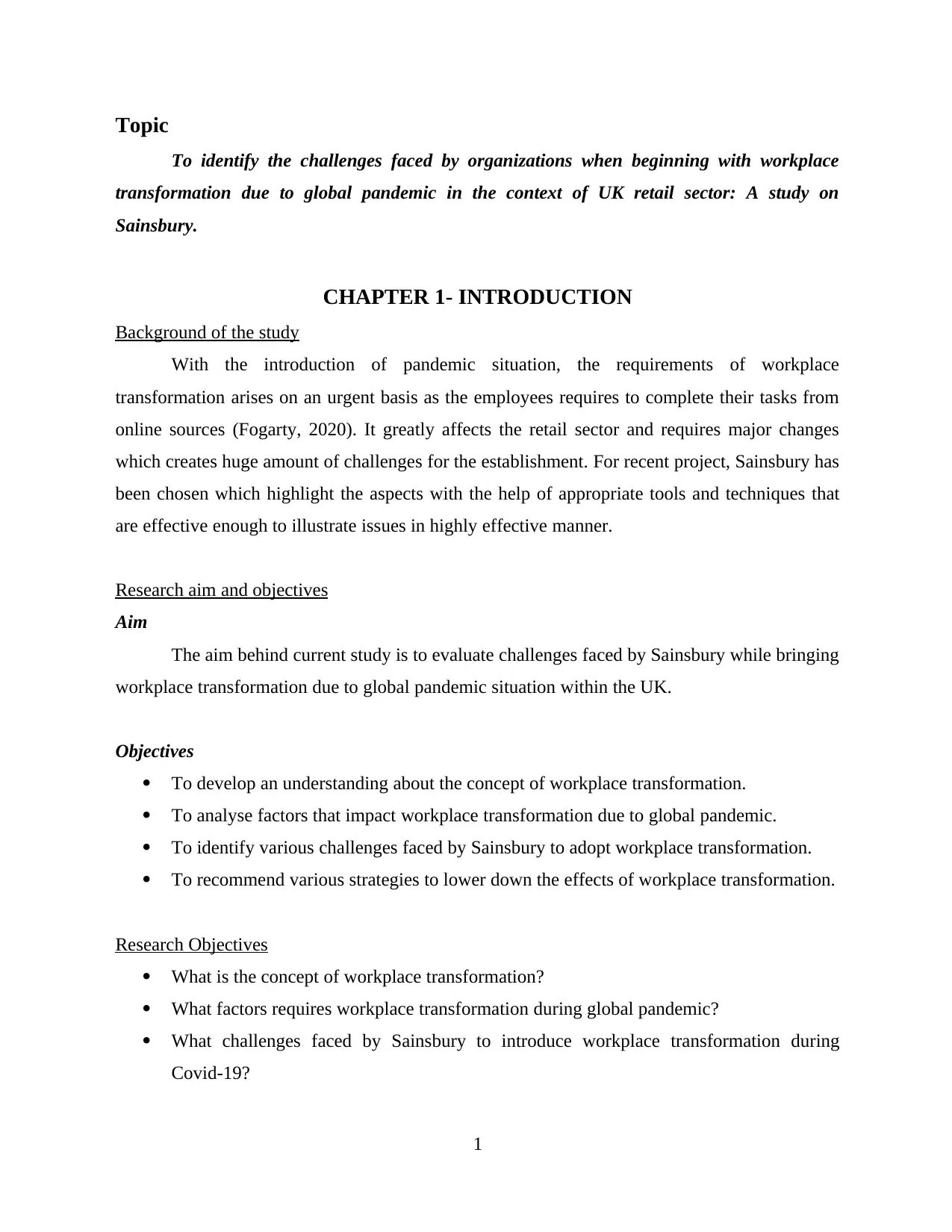
Topic
To identify the challenges faced by organizations when beginning with workplace
transformation due to global pandemic in the context of UK retail sector: A study on
Sainsbury.
CHAPTER 1- INTRODUCTION
Background of the study
With the introduction of pandemic situation, the requirements of workplace
transformation arises on an urgent basis as the employees requires to complete their tasks from
online sources (Fogarty, 2020). It greatly affects the retail sector and requires major changes
which creates huge amount of challenges for the establishment. For recent project, Sainsbury has
been chosen which highlight the aspects with the help of appropriate tools and techniques that
are effective enough to illustrate issues in highly effective manner.
Research aim and objectives
Aim
The aim behind current study is to evaluate challenges faced by Sainsbury while bringing
workplace transformation due to global pandemic situation within the UK.
Objectives
To develop an understanding about the concept of workplace transformation.
To analyse factors that impact workplace transformation due to global pandemic.
To identify various challenges faced by Sainsbury to adopt workplace transformation.
To recommend various strategies to lower down the effects of workplace transformation.
Research Objectives
What is the concept of workplace transformation?
What factors requires workplace transformation during global pandemic?
What challenges faced by Sainsbury to introduce workplace transformation during
Covid-19?
1
To identify the challenges faced by organizations when beginning with workplace
transformation due to global pandemic in the context of UK retail sector: A study on
Sainsbury.
CHAPTER 1- INTRODUCTION
Background of the study
With the introduction of pandemic situation, the requirements of workplace
transformation arises on an urgent basis as the employees requires to complete their tasks from
online sources (Fogarty, 2020). It greatly affects the retail sector and requires major changes
which creates huge amount of challenges for the establishment. For recent project, Sainsbury has
been chosen which highlight the aspects with the help of appropriate tools and techniques that
are effective enough to illustrate issues in highly effective manner.
Research aim and objectives
Aim
The aim behind current study is to evaluate challenges faced by Sainsbury while bringing
workplace transformation due to global pandemic situation within the UK.
Objectives
To develop an understanding about the concept of workplace transformation.
To analyse factors that impact workplace transformation due to global pandemic.
To identify various challenges faced by Sainsbury to adopt workplace transformation.
To recommend various strategies to lower down the effects of workplace transformation.
Research Objectives
What is the concept of workplace transformation?
What factors requires workplace transformation during global pandemic?
What challenges faced by Sainsbury to introduce workplace transformation during
Covid-19?
1
⊘ This is a preview!⊘
Do you want full access?
Subscribe today to unlock all pages.

Trusted by 1+ million students worldwide
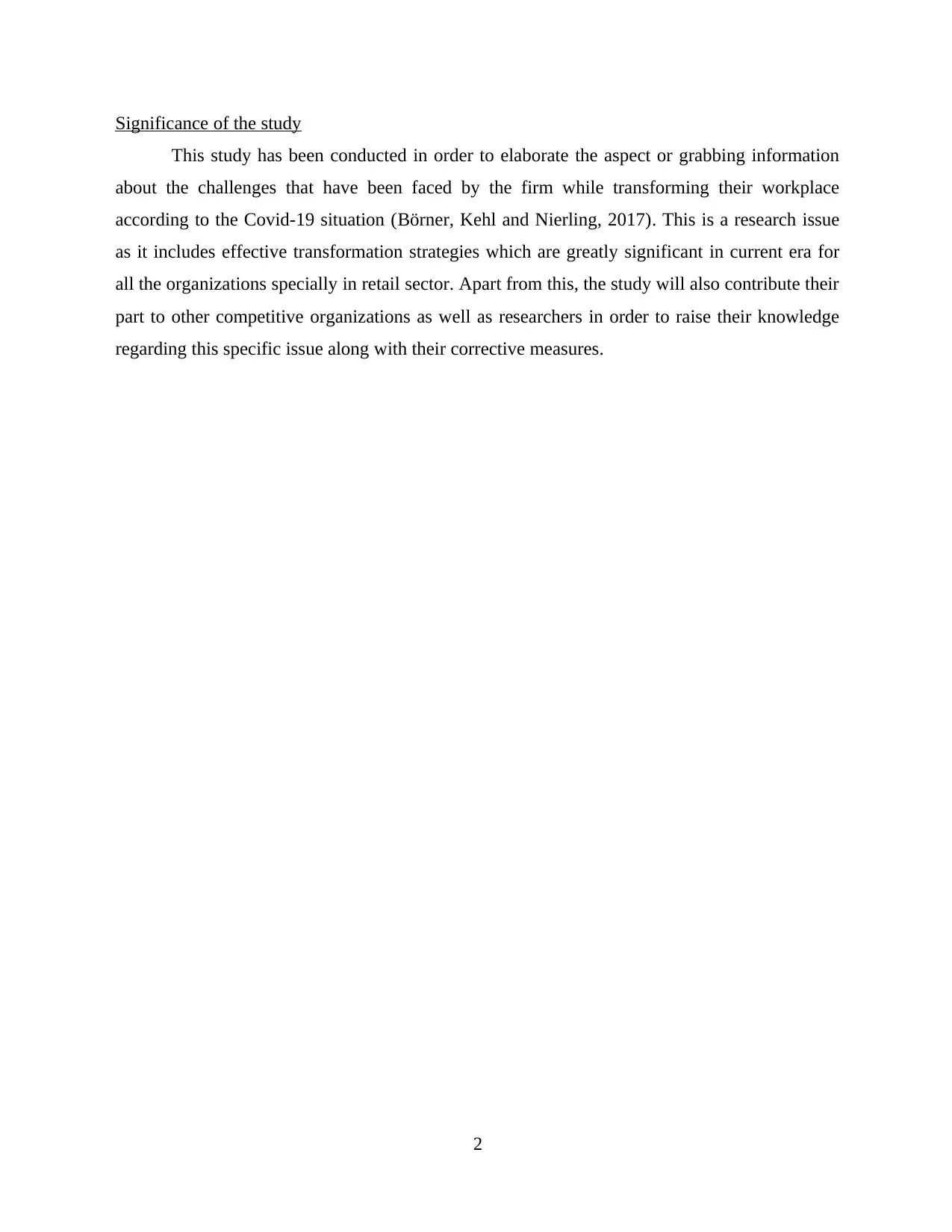
Significance of the study
This study has been conducted in order to elaborate the aspect or grabbing information
about the challenges that have been faced by the firm while transforming their workplace
according to the Covid-19 situation (Börner, Kehl and Nierling, 2017). This is a research issue
as it includes effective transformation strategies which are greatly significant in current era for
all the organizations specially in retail sector. Apart from this, the study will also contribute their
part to other competitive organizations as well as researchers in order to raise their knowledge
regarding this specific issue along with their corrective measures.
2
This study has been conducted in order to elaborate the aspect or grabbing information
about the challenges that have been faced by the firm while transforming their workplace
according to the Covid-19 situation (Börner, Kehl and Nierling, 2017). This is a research issue
as it includes effective transformation strategies which are greatly significant in current era for
all the organizations specially in retail sector. Apart from this, the study will also contribute their
part to other competitive organizations as well as researchers in order to raise their knowledge
regarding this specific issue along with their corrective measures.
2
Paraphrase This Document
Need a fresh take? Get an instant paraphrase of this document with our AI Paraphraser
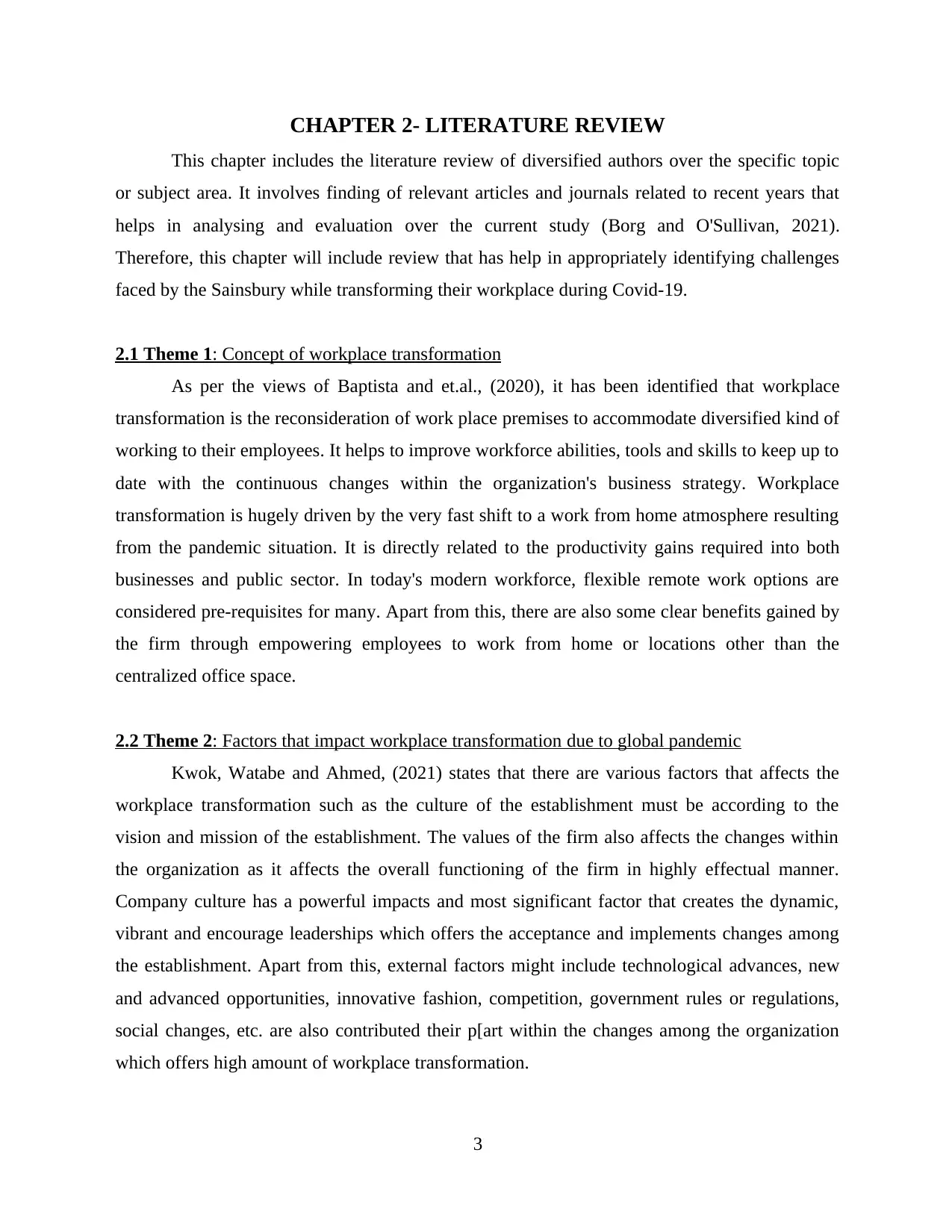
CHAPTER 2- LITERATURE REVIEW
This chapter includes the literature review of diversified authors over the specific topic
or subject area. It involves finding of relevant articles and journals related to recent years that
helps in analysing and evaluation over the current study (Borg and O'Sullivan, 2021).
Therefore, this chapter will include review that has help in appropriately identifying challenges
faced by the Sainsbury while transforming their workplace during Covid-19.
2.1 Theme 1: Concept of workplace transformation
As per the views of Baptista and et.al., (2020), it has been identified that workplace
transformation is the reconsideration of work place premises to accommodate diversified kind of
working to their employees. It helps to improve workforce abilities, tools and skills to keep up to
date with the continuous changes within the organization's business strategy. Workplace
transformation is hugely driven by the very fast shift to a work from home atmosphere resulting
from the pandemic situation. It is directly related to the productivity gains required into both
businesses and public sector. In today's modern workforce, flexible remote work options are
considered pre-requisites for many. Apart from this, there are also some clear benefits gained by
the firm through empowering employees to work from home or locations other than the
centralized office space.
2.2 Theme 2: Factors that impact workplace transformation due to global pandemic
Kwok, Watabe and Ahmed, (2021) states that there are various factors that affects the
workplace transformation such as the culture of the establishment must be according to the
vision and mission of the establishment. The values of the firm also affects the changes within
the organization as it affects the overall functioning of the firm in highly effectual manner.
Company culture has a powerful impacts and most significant factor that creates the dynamic,
vibrant and encourage leaderships which offers the acceptance and implements changes among
the establishment. Apart from this, external factors might include technological advances, new
and advanced opportunities, innovative fashion, competition, government rules or regulations,
social changes, etc. are also contributed their p[art within the changes among the organization
which offers high amount of workplace transformation.
3
This chapter includes the literature review of diversified authors over the specific topic
or subject area. It involves finding of relevant articles and journals related to recent years that
helps in analysing and evaluation over the current study (Borg and O'Sullivan, 2021).
Therefore, this chapter will include review that has help in appropriately identifying challenges
faced by the Sainsbury while transforming their workplace during Covid-19.
2.1 Theme 1: Concept of workplace transformation
As per the views of Baptista and et.al., (2020), it has been identified that workplace
transformation is the reconsideration of work place premises to accommodate diversified kind of
working to their employees. It helps to improve workforce abilities, tools and skills to keep up to
date with the continuous changes within the organization's business strategy. Workplace
transformation is hugely driven by the very fast shift to a work from home atmosphere resulting
from the pandemic situation. It is directly related to the productivity gains required into both
businesses and public sector. In today's modern workforce, flexible remote work options are
considered pre-requisites for many. Apart from this, there are also some clear benefits gained by
the firm through empowering employees to work from home or locations other than the
centralized office space.
2.2 Theme 2: Factors that impact workplace transformation due to global pandemic
Kwok, Watabe and Ahmed, (2021) states that there are various factors that affects the
workplace transformation such as the culture of the establishment must be according to the
vision and mission of the establishment. The values of the firm also affects the changes within
the organization as it affects the overall functioning of the firm in highly effectual manner.
Company culture has a powerful impacts and most significant factor that creates the dynamic,
vibrant and encourage leaderships which offers the acceptance and implements changes among
the establishment. Apart from this, external factors might include technological advances, new
and advanced opportunities, innovative fashion, competition, government rules or regulations,
social changes, etc. are also contributed their p[art within the changes among the organization
which offers high amount of workplace transformation.
3
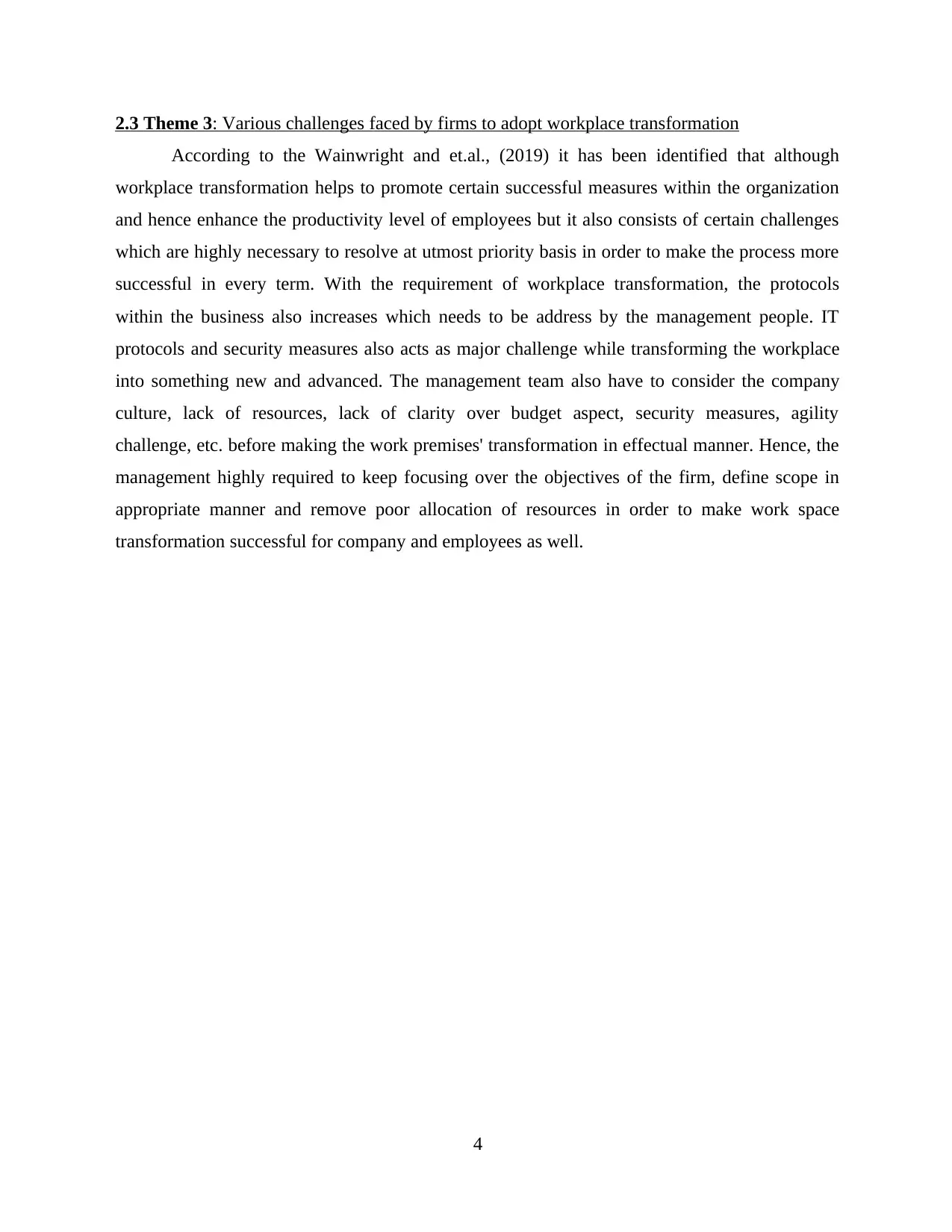
2.3 Theme 3: Various challenges faced by firms to adopt workplace transformation
According to the Wainwright and et.al., (2019) it has been identified that although
workplace transformation helps to promote certain successful measures within the organization
and hence enhance the productivity level of employees but it also consists of certain challenges
which are highly necessary to resolve at utmost priority basis in order to make the process more
successful in every term. With the requirement of workplace transformation, the protocols
within the business also increases which needs to be address by the management people. IT
protocols and security measures also acts as major challenge while transforming the workplace
into something new and advanced. The management team also have to consider the company
culture, lack of resources, lack of clarity over budget aspect, security measures, agility
challenge, etc. before making the work premises' transformation in effectual manner. Hence, the
management highly required to keep focusing over the objectives of the firm, define scope in
appropriate manner and remove poor allocation of resources in order to make work space
transformation successful for company and employees as well.
4
According to the Wainwright and et.al., (2019) it has been identified that although
workplace transformation helps to promote certain successful measures within the organization
and hence enhance the productivity level of employees but it also consists of certain challenges
which are highly necessary to resolve at utmost priority basis in order to make the process more
successful in every term. With the requirement of workplace transformation, the protocols
within the business also increases which needs to be address by the management people. IT
protocols and security measures also acts as major challenge while transforming the workplace
into something new and advanced. The management team also have to consider the company
culture, lack of resources, lack of clarity over budget aspect, security measures, agility
challenge, etc. before making the work premises' transformation in effectual manner. Hence, the
management highly required to keep focusing over the objectives of the firm, define scope in
appropriate manner and remove poor allocation of resources in order to make work space
transformation successful for company and employees as well.
4
⊘ This is a preview!⊘
Do you want full access?
Subscribe today to unlock all pages.

Trusted by 1+ million students worldwide
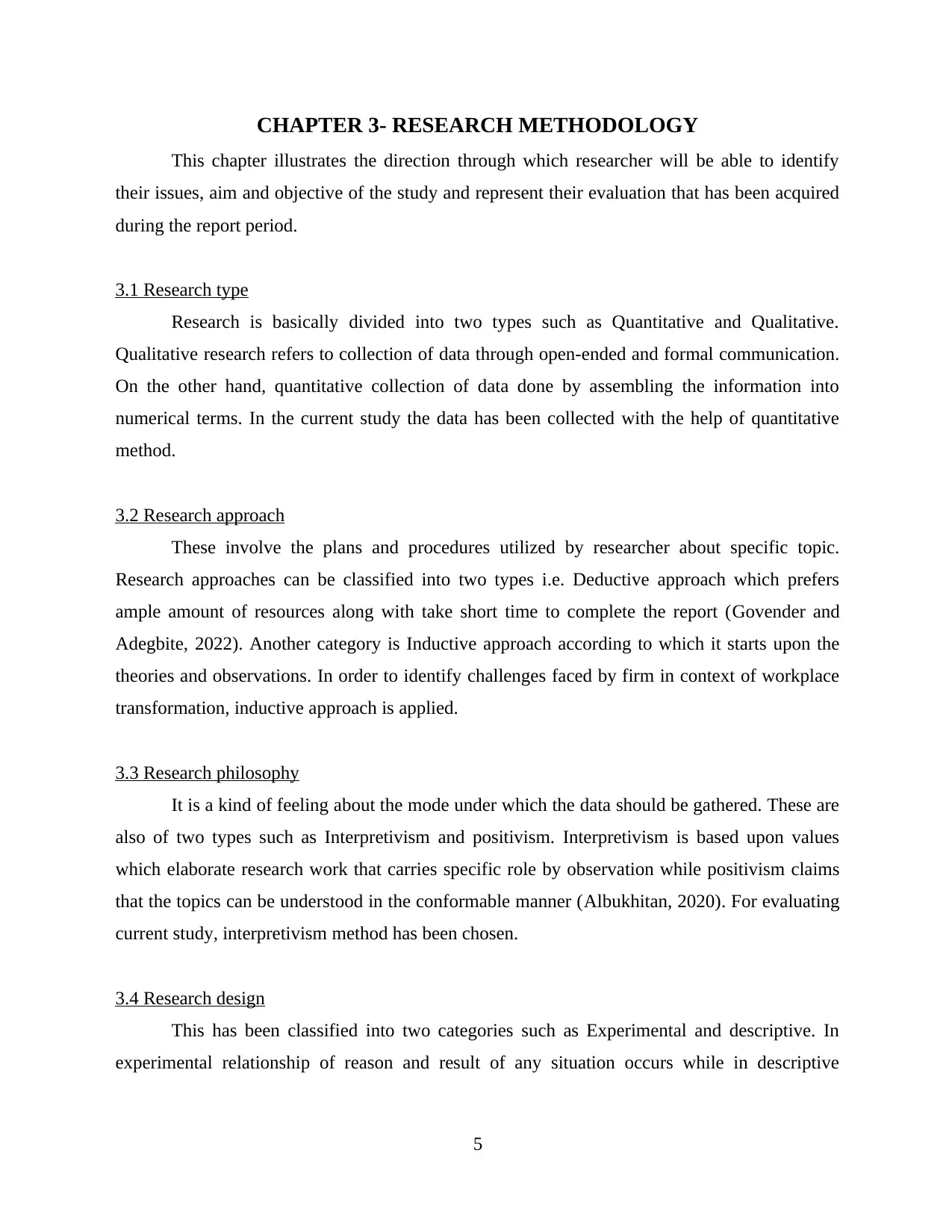
CHAPTER 3- RESEARCH METHODOLOGY
This chapter illustrates the direction through which researcher will be able to identify
their issues, aim and objective of the study and represent their evaluation that has been acquired
during the report period.
3.1 Research type
Research is basically divided into two types such as Quantitative and Qualitative.
Qualitative research refers to collection of data through open-ended and formal communication.
On the other hand, quantitative collection of data done by assembling the information into
numerical terms. In the current study the data has been collected with the help of quantitative
method.
3.2 Research approach
These involve the plans and procedures utilized by researcher about specific topic.
Research approaches can be classified into two types i.e. Deductive approach which prefers
ample amount of resources along with take short time to complete the report (Govender and
Adegbite, 2022). Another category is Inductive approach according to which it starts upon the
theories and observations. In order to identify challenges faced by firm in context of workplace
transformation, inductive approach is applied.
3.3 Research philosophy
It is a kind of feeling about the mode under which the data should be gathered. These are
also of two types such as Interpretivism and positivism. Interpretivism is based upon values
which elaborate research work that carries specific role by observation while positivism claims
that the topics can be understood in the conformable manner (Albukhitan, 2020). For evaluating
current study, interpretivism method has been chosen.
3.4 Research design
This has been classified into two categories such as Experimental and descriptive. In
experimental relationship of reason and result of any situation occurs while in descriptive
5
This chapter illustrates the direction through which researcher will be able to identify
their issues, aim and objective of the study and represent their evaluation that has been acquired
during the report period.
3.1 Research type
Research is basically divided into two types such as Quantitative and Qualitative.
Qualitative research refers to collection of data through open-ended and formal communication.
On the other hand, quantitative collection of data done by assembling the information into
numerical terms. In the current study the data has been collected with the help of quantitative
method.
3.2 Research approach
These involve the plans and procedures utilized by researcher about specific topic.
Research approaches can be classified into two types i.e. Deductive approach which prefers
ample amount of resources along with take short time to complete the report (Govender and
Adegbite, 2022). Another category is Inductive approach according to which it starts upon the
theories and observations. In order to identify challenges faced by firm in context of workplace
transformation, inductive approach is applied.
3.3 Research philosophy
It is a kind of feeling about the mode under which the data should be gathered. These are
also of two types such as Interpretivism and positivism. Interpretivism is based upon values
which elaborate research work that carries specific role by observation while positivism claims
that the topics can be understood in the conformable manner (Albukhitan, 2020). For evaluating
current study, interpretivism method has been chosen.
3.4 Research design
This has been classified into two categories such as Experimental and descriptive. In
experimental relationship of reason and result of any situation occurs while in descriptive
5
Paraphrase This Document
Need a fresh take? Get an instant paraphrase of this document with our AI Paraphraser
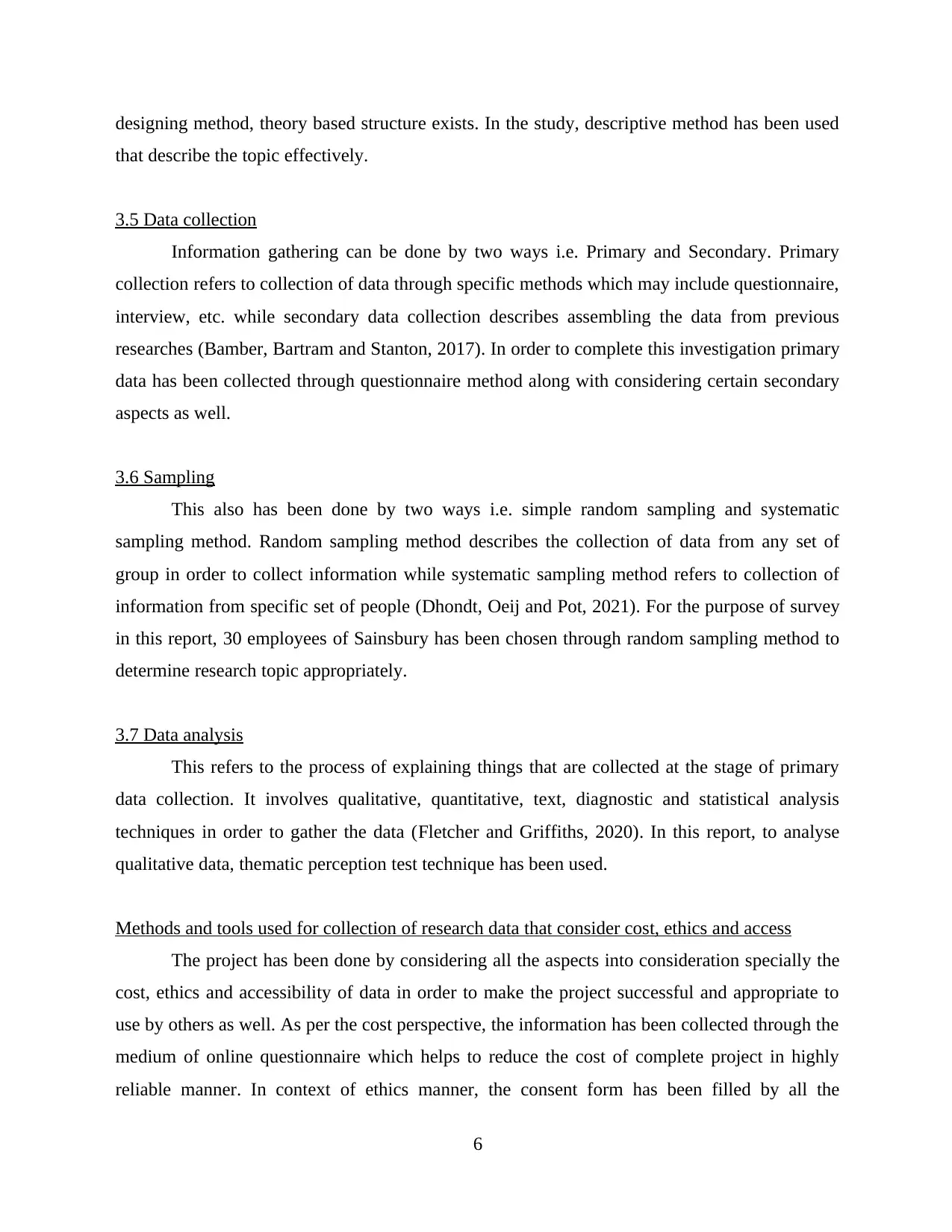
designing method, theory based structure exists. In the study, descriptive method has been used
that describe the topic effectively.
3.5 Data collection
Information gathering can be done by two ways i.e. Primary and Secondary. Primary
collection refers to collection of data through specific methods which may include questionnaire,
interview, etc. while secondary data collection describes assembling the data from previous
researches (Bamber, Bartram and Stanton, 2017). In order to complete this investigation primary
data has been collected through questionnaire method along with considering certain secondary
aspects as well.
3.6 Sampling
This also has been done by two ways i.e. simple random sampling and systematic
sampling method. Random sampling method describes the collection of data from any set of
group in order to collect information while systematic sampling method refers to collection of
information from specific set of people (Dhondt, Oeij and Pot, 2021). For the purpose of survey
in this report, 30 employees of Sainsbury has been chosen through random sampling method to
determine research topic appropriately.
3.7 Data analysis
This refers to the process of explaining things that are collected at the stage of primary
data collection. It involves qualitative, quantitative, text, diagnostic and statistical analysis
techniques in order to gather the data (Fletcher and Griffiths, 2020). In this report, to analyse
qualitative data, thematic perception test technique has been used.
Methods and tools used for collection of research data that consider cost, ethics and access
The project has been done by considering all the aspects into consideration specially the
cost, ethics and accessibility of data in order to make the project successful and appropriate to
use by others as well. As per the cost perspective, the information has been collected through the
medium of online questionnaire which helps to reduce the cost of complete project in highly
reliable manner. In context of ethics manner, the consent form has been filled by all the
6
that describe the topic effectively.
3.5 Data collection
Information gathering can be done by two ways i.e. Primary and Secondary. Primary
collection refers to collection of data through specific methods which may include questionnaire,
interview, etc. while secondary data collection describes assembling the data from previous
researches (Bamber, Bartram and Stanton, 2017). In order to complete this investigation primary
data has been collected through questionnaire method along with considering certain secondary
aspects as well.
3.6 Sampling
This also has been done by two ways i.e. simple random sampling and systematic
sampling method. Random sampling method describes the collection of data from any set of
group in order to collect information while systematic sampling method refers to collection of
information from specific set of people (Dhondt, Oeij and Pot, 2021). For the purpose of survey
in this report, 30 employees of Sainsbury has been chosen through random sampling method to
determine research topic appropriately.
3.7 Data analysis
This refers to the process of explaining things that are collected at the stage of primary
data collection. It involves qualitative, quantitative, text, diagnostic and statistical analysis
techniques in order to gather the data (Fletcher and Griffiths, 2020). In this report, to analyse
qualitative data, thematic perception test technique has been used.
Methods and tools used for collection of research data that consider cost, ethics and access
The project has been done by considering all the aspects into consideration specially the
cost, ethics and accessibility of data in order to make the project successful and appropriate to
use by others as well. As per the cost perspective, the information has been collected through the
medium of online questionnaire which helps to reduce the cost of complete project in highly
reliable manner. In context of ethics manner, the consent form has been filled by all the
6

randomly selected candidates of the firm (Virdee, 2021). Furthermore, a list of references also
have been attached to possess that the work has not being copied from somewhere else.
Moreover, in terms of accessibility, the data has been represented in a manner which is highly
accessible to each and every person along with fulfils reliability aspect i.e. the data has been
collected from the sources that are published after year 2017.
7
have been attached to possess that the work has not being copied from somewhere else.
Moreover, in terms of accessibility, the data has been represented in a manner which is highly
accessible to each and every person along with fulfils reliability aspect i.e. the data has been
collected from the sources that are published after year 2017.
7
⊘ This is a preview!⊘
Do you want full access?
Subscribe today to unlock all pages.

Trusted by 1+ million students worldwide
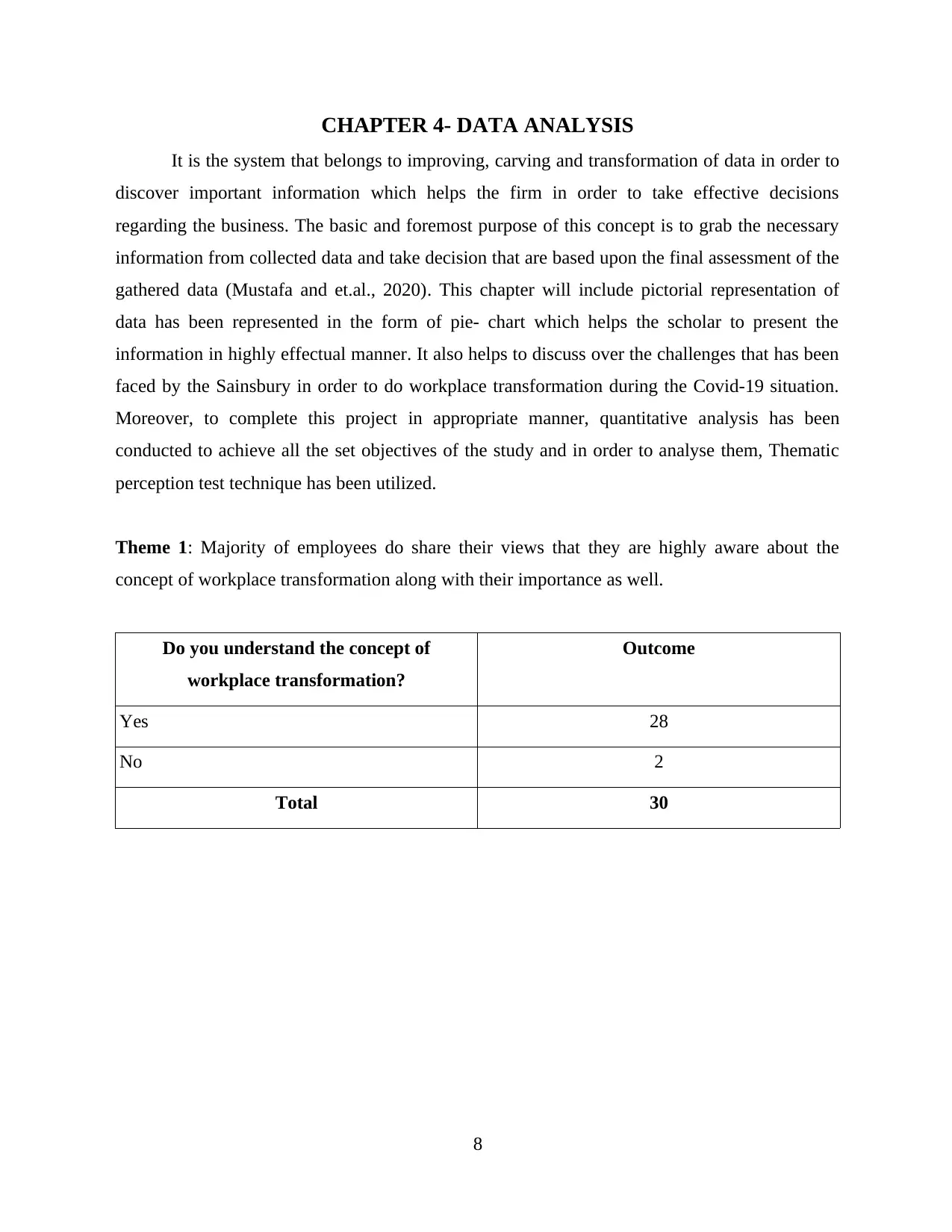
CHAPTER 4- DATA ANALYSIS
It is the system that belongs to improving, carving and transformation of data in order to
discover important information which helps the firm in order to take effective decisions
regarding the business. The basic and foremost purpose of this concept is to grab the necessary
information from collected data and take decision that are based upon the final assessment of the
gathered data (Mustafa and et.al., 2020). This chapter will include pictorial representation of
data has been represented in the form of pie- chart which helps the scholar to present the
information in highly effectual manner. It also helps to discuss over the challenges that has been
faced by the Sainsbury in order to do workplace transformation during the Covid-19 situation.
Moreover, to complete this project in appropriate manner, quantitative analysis has been
conducted to achieve all the set objectives of the study and in order to analyse them, Thematic
perception test technique has been utilized.
Theme 1: Majority of employees do share their views that they are highly aware about the
concept of workplace transformation along with their importance as well.
Do you understand the concept of
workplace transformation?
Outcome
Yes 28
No 2
Total 30
8
It is the system that belongs to improving, carving and transformation of data in order to
discover important information which helps the firm in order to take effective decisions
regarding the business. The basic and foremost purpose of this concept is to grab the necessary
information from collected data and take decision that are based upon the final assessment of the
gathered data (Mustafa and et.al., 2020). This chapter will include pictorial representation of
data has been represented in the form of pie- chart which helps the scholar to present the
information in highly effectual manner. It also helps to discuss over the challenges that has been
faced by the Sainsbury in order to do workplace transformation during the Covid-19 situation.
Moreover, to complete this project in appropriate manner, quantitative analysis has been
conducted to achieve all the set objectives of the study and in order to analyse them, Thematic
perception test technique has been utilized.
Theme 1: Majority of employees do share their views that they are highly aware about the
concept of workplace transformation along with their importance as well.
Do you understand the concept of
workplace transformation?
Outcome
Yes 28
No 2
Total 30
8
Paraphrase This Document
Need a fresh take? Get an instant paraphrase of this document with our AI Paraphraser
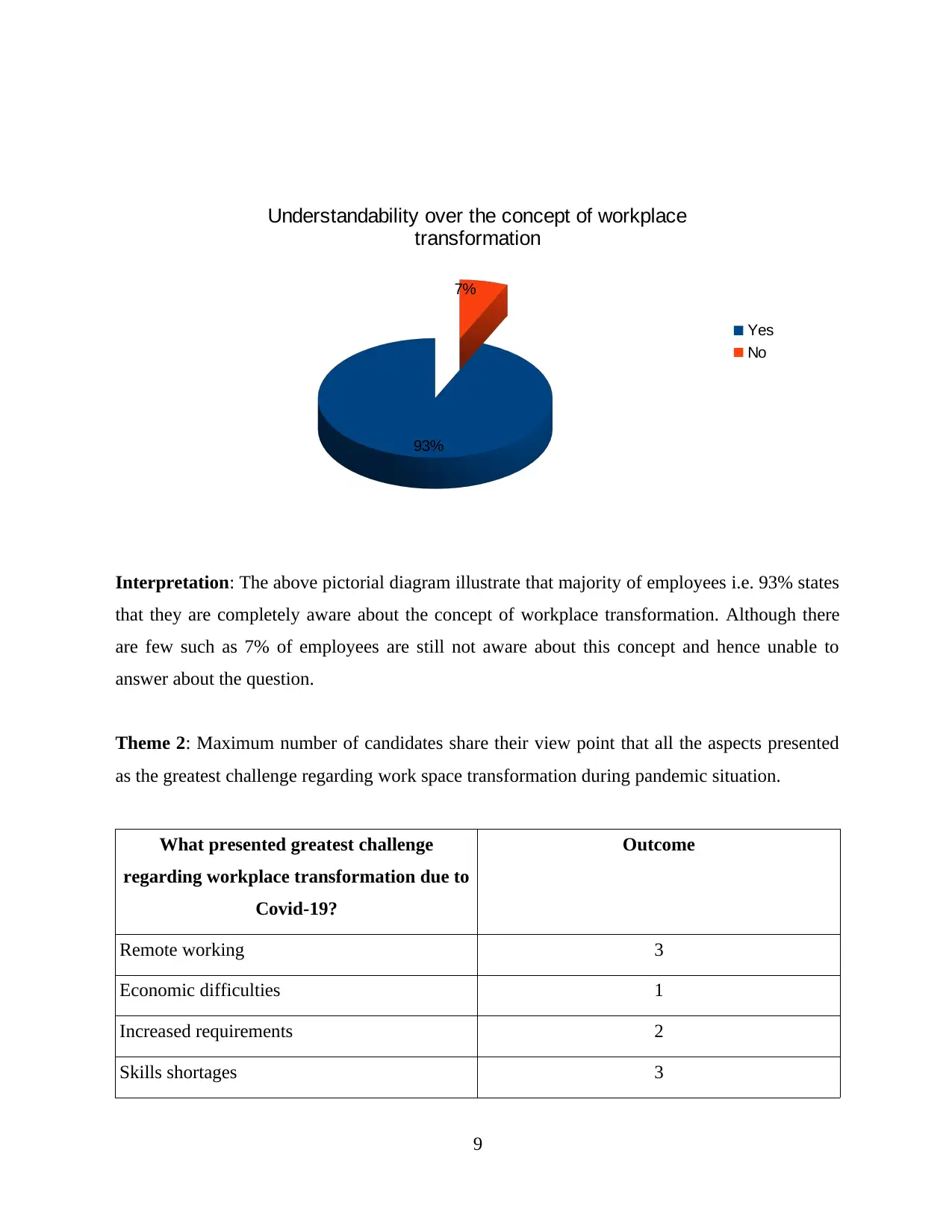
Interpretation: The above pictorial diagram illustrate that majority of employees i.e. 93% states
that they are completely aware about the concept of workplace transformation. Although there
are few such as 7% of employees are still not aware about this concept and hence unable to
answer about the question.
Theme 2: Maximum number of candidates share their view point that all the aspects presented
as the greatest challenge regarding work space transformation during pandemic situation.
What presented greatest challenge
regarding workplace transformation due to
Covid-19?
Outcome
Remote working 3
Economic difficulties 1
Increased requirements 2
Skills shortages 3
9
93%
7%
Understandability over the concept of workplace
transformation
Yes
No
that they are completely aware about the concept of workplace transformation. Although there
are few such as 7% of employees are still not aware about this concept and hence unable to
answer about the question.
Theme 2: Maximum number of candidates share their view point that all the aspects presented
as the greatest challenge regarding work space transformation during pandemic situation.
What presented greatest challenge
regarding workplace transformation due to
Covid-19?
Outcome
Remote working 3
Economic difficulties 1
Increased requirements 2
Skills shortages 3
9
93%
7%
Understandability over the concept of workplace
transformation
Yes
No
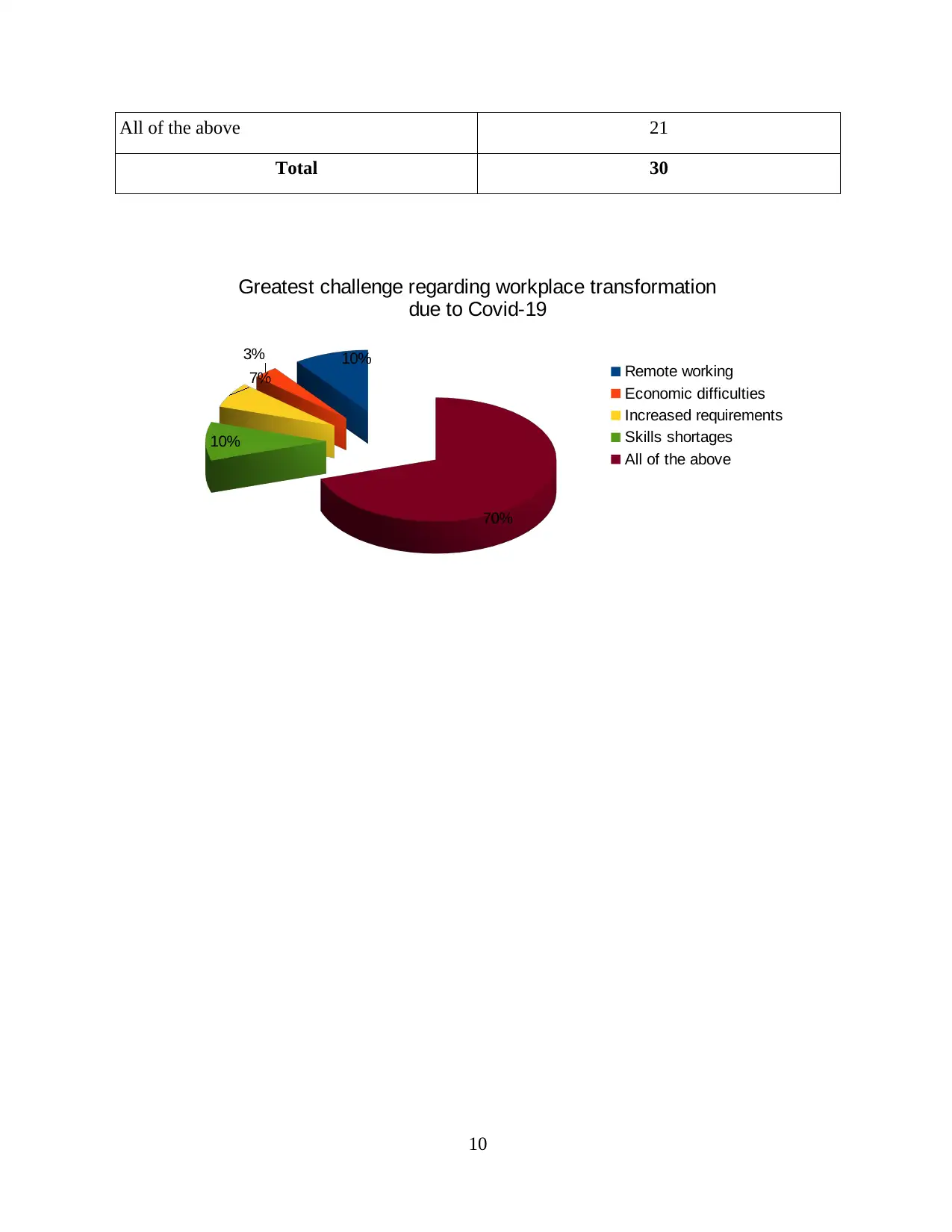
All of the above 21
Total 30
10
10%3%
7%
10%
70%
Greatest challenge regarding workplace transformation
due to Covid-19
Remote working
Economic difficulties
Increased requirements
Skills shortages
All of the above
Total 30
10
10%3%
7%
10%
70%
Greatest challenge regarding workplace transformation
due to Covid-19
Remote working
Economic difficulties
Increased requirements
Skills shortages
All of the above
⊘ This is a preview!⊘
Do you want full access?
Subscribe today to unlock all pages.

Trusted by 1+ million students worldwide
1 out of 25
Related Documents
Your All-in-One AI-Powered Toolkit for Academic Success.
+13062052269
info@desklib.com
Available 24*7 on WhatsApp / Email
![[object Object]](/_next/static/media/star-bottom.7253800d.svg)
Unlock your academic potential
Copyright © 2020–2025 A2Z Services. All Rights Reserved. Developed and managed by ZUCOL.



